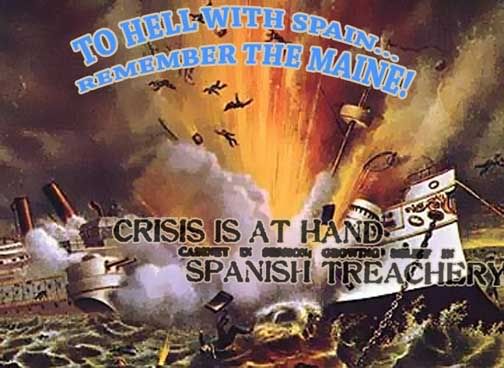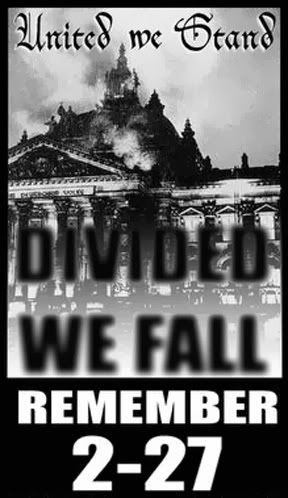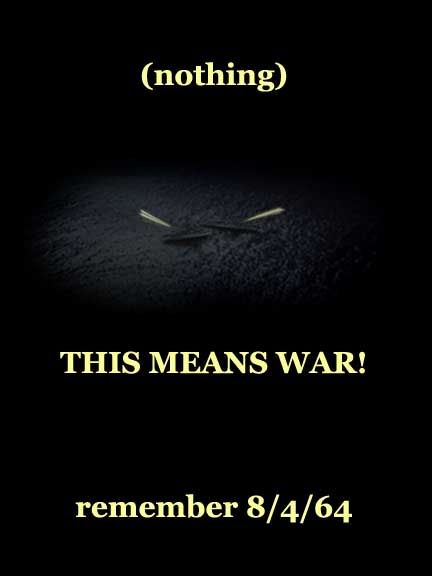Adam Larson / Caustic Logic
June 2 2009
last edit 6/5 2am
THE STAGE IS SET: HERRICK TO ELLSBERG
When I was debating Pearl Harbor at the JREF forum a few months back, Screw Loose Change co-creator “Brainster” countered any design for loss on FDR’s part with the observation that “zero US deaths on the USS Maddox led to [the war in] Vietnam.” “Too true!” I responded eagerly, knowing just enough about this incident, continuing:
“And look at how well that war went! Can you imagine if FDR had tried to base WWfrigginII on some fake out boat incident deep inside Japan's sphere of influence? You think hippies on campus caused a problem, right wingers have guns and such... I know it sounds a stretch to say the event shapes the war, but on some level it does, the question is how much.” [1]
This passing thought came back to a point when I learned – last night - that Daniel Ellsberg, the Pentagon insider-turned dissident who was among the chief actors in the war’s undoing - was there as it started on the wrong foot. In his memoirs he reveals he was the man at the Pentagon who first received Captain Herrick’s reports about the attack, opening his book on the war of lies with this episode, and so I’ll open my Tonkin Gulf inquiry here as well.
”On Tuesday morning, August 4, 1964, my first full day on my new job in the Pentagon, a courier came into the outer office with an urgent cable for my boss. He'd been running. The secretaries told him Assistant Secretary John McNaughton was out of the office; he was down the hall with Secretary of Defense Robert McNamara. They pointed him to me, his new Special Assistant. The courier handed me the cable and left. It was easy to see, as I read it, why he had been running.
It was from Captain John J. Herrick, the commodore of a two-destroyer flotilla in the Tonkin Gulf, off North Vietnam in the South China Sea. He said he was under attack by North Vietnamese patrol boats and he had opened fire on them.
[…] Within ten minutes he was back to me with another cable from the same series: "Am under continuous torpedo attack." […] A few minutes later, Herrick reported another torpedo had run by him, and that two more were in the water. […] The messages were vivid. [...] "Have. . . successfully avoided at least six torpedoes."
Nine torpedoes had been fired at his ships, fourteen, twenty-six: the sea was awash with torpedoes. More attacking boats had been hit, at least one sunk. This action wasn't ending after forty minutes or an hour. It was going on, ships dodging and firing in choppy seas, planes overhead firing rockets at locations given them by the Turner Joy's radar, for an incredible two hours before the stream of continuous combat updates finally ended.” [2]
I’m having a hard time locating any clear versions of these early communications besides snippets like these re-printed from obscure works, but their gist is clear – a major prolonged attack supported by many fast-moving reports.
MANY DOUBTS/MY TRANSLATION
About an hour after the last battle message, however, there came a “full stop,” Ellsberg recalls. “A message arrived that took back not quite all of it, but enough of it to put everything earlier in question.” [3] This follow-up message introducing doubts is more widely quoted and read thus:
“Review of action makes many recorded contacts and torpedoes fired appear doubtful. Freak weather effects and over-eager sonarman may have accounted for many reports. No actual visual sightings by Maddox. Suggest complete evaluation before any further action.” [4]
Well this is certainly a bizarre thing to say after an hours-long battle one had barely survived. This incongruous uncertainty triggered what witer Eric Alterman called “a flurry of pointed inquiries from the highest levels of the Pentagon” [5] which in turn prompted another rosier report with more evidence of attack after all:
"Further recap reveals Turner Joy fired upon by small-caliber guns and illuminated by searchlight. Joy tracked two sets of contacts. Fired on 13 contacts. Claim positive hits 1, 1 sunk, probabe hits 3. Joy also reports no actual visual sightings or wake. Have no recap of aircraft sightings but seemed to be few. Entire action leaves many doubts except for apparent attempted ambush at beginning. Suggest thorough reconnaissance in daylight by aircraft.” [6]
Captain Herrick seems to be operating here in a world different from the three-dimensional one we all inhabit, and his words are less reflection of coherent truth than impressionist brush strokes suggesting a possible reality that could be taken or left. From my intuition and the moderate amount I know about this incident, he seems to be saying “we were viciously attacked, maybe, probably not, but maybe, definitely we think – look, we don’t know, if you think we did then we did. Check it out yourselves, if you want, but that’s our report. We got attacked. Can we go home now?”
Rendering an accurate translation takes a knowledge of context, foremost the “Desoto patrol” that had both Maddox and its danger-zone company Turner Joy sent again into this Gulf to spy and to defy attacks. This was carried out alongside “OPLAN 34A” provocations feeding off-Desoto intel and stirring up more. Some stimulated reactions, the President had already decided, could only be met with military firmness. Maddox had been attacked two days before, on August 2. LBJ seemed to feel he needed two such events in order to get firm while seeming well-justified, and the provoke-then-patrol system was continued.
The Maddox was given a partner, Turner Joy for the mission of the 4th and promised air cover. Herrick had been alerted of new 34A provocations, and received Pentagon warnings of another imminent attack, and yet his protests to just cancel it as an “unacceptable risk” were denied. Thus the captains of both ships were given every reason to both worry about torpedo strikes and sinking, and to think about why they were being exposed to such danger. It seems possible that this inspired them to simply imagine the inevitable attack hoping - perhaps unconsciously - that a false report would give the leadership what it wanted without the pain and death of a real attack. This is just an uniformed impression from a cynical blogger, but there it is.
THE BASTARD PIMP LBJ’S TRANSLATION
President Johnson and his top aides all claimed to believe the attack reports, at least at first, when it mattered. But LBJ’s words on September 18 show he was aware there was no attack, that his own case upon which the war was escalating by his choice, was fraudulent. White House recordings, released in 2001, transcribed by Eric Alterman for his book When Presidents Lie. In a discussion with Secretary of Defense MacNamara, Johnson reminds him that “you just came in … a few weeks ago and said that “Damn, they are launching an attack on us – they are firing on us.” When we got through with all the firing we concluded maybe they hadn’t fired at all.” [7] This is both an accurate summary of what happened in the Gulf, and a metaphor for the larger movement of the national “we” and its reaction of retaliatory bombing and resolution-passing.
“I have found over the years that we see and we hear and we imagine a lot of things in the form of stacks and shots and people running at us,” he sad, apparently explaining why the erred reports both make sense and annoy him. It would “make us very vulnerable,” he told MacNamara, if it that were the case here, and the reported attack they were then starting a war over “just wasn’t true at all.” He shows signs of believing just this, while proceeding full-tilt in that vulnerability. “It looks like to me they would hear a shot or see a shot or do something before they get worked up […] I want to be tough where we … are justified being tough … But I sure want more caution on the part of these admirals and these destroyer commanders … about whether they are being fired on or not.” [8]
He seemed less concerned with the truthfulness of the reports than with their ambiguity. “I don't know why in the hell, some time or other, they can't be sure that they are being attacked.” There are only two alternatives to flase attack reports, and it’s not clear which he’s looking for – no attacks, as had been happening so far with Hanoi trying to avoid a confrontation, or true reports of real attacks. [9]
Finally, this bastard summoned the chutzpah to re-state himself thus: “I don’t want them just being some change o’life woman running up and saying that, by God, she was being raped just because a man walks into the room!” [10] This from the man who approved and endorsed the system that had their “women” regularly sent into rooms already crowded with leering, pornography-addled men (buzzed-to-drunk on liquor air-dropped just before their women arrived) – to “assert their right as women to go where they please” and study the psycho-sexual behavior of the "men" in the "room."
By God, the President doesn’t want to hear some prudish false charges. Under the circumstances, should a real rape be so hard to come by? Or at least a more convincing made-up one? Those Texas knuckles are aching to make contact with a genuine rapist’s face! If the guys in the Gulf made the call I outlined above, it worked in the end, and the beatings did commence, even if the chief was frustrated with his silly little "women."
Sources:
[1] http://forums.randi.org/showthread.php?t=136679&page=2
[2], [3] Ellsberg, Daniel. Secrets: A Memoir of Vietnam and the Pentagon Papers Chapter one. http://www.kean.edu/~ggluck/EllsbergChapterOne.htm
[4, 5, 6] Alterman, Eric. When Presidents Lie. Viking. 2004.Page 188.
[7, 8, 9, 10] Alterman. pp 201-202.













No comments:
Post a Comment